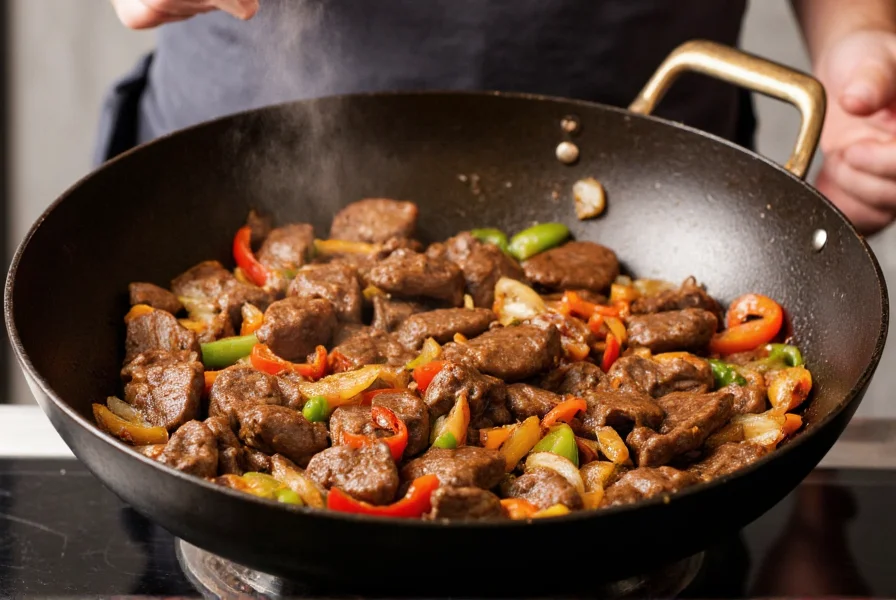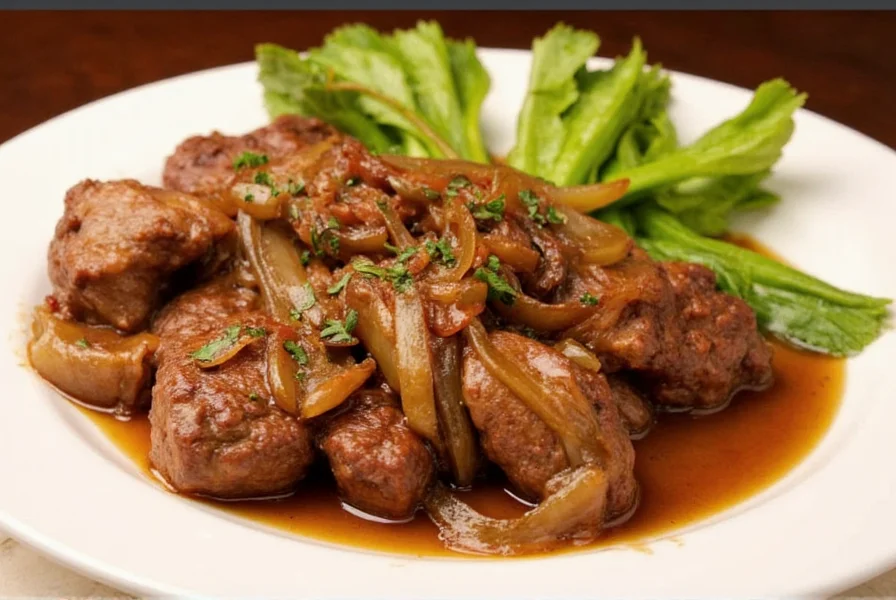Originating from Chinese-American cuisine, pepper steak and onion has become a staple in many households and restaurants worldwide. This versatile dish combines the rich flavor of beef with the sweet crunch of bell peppers and the aromatic depth of onions, creating a balanced meal that's both satisfying and relatively simple to prepare when you know the right techniques.
The History Behind Pepper Steak and Onion
While often associated with Chinese-American cuisine, pepper steak actually has roots in traditional Chinese cooking that was adapted for Western palates. The dish emerged in the mid-20th century as Chinese immigrants modified their recipes to incorporate ingredients more readily available in America. Unlike many authentic Chinese dishes that use a wider variety of peppers, the American version standardized on bell peppers, creating the "pepper steak" we know today.
Choosing the Perfect Cut for Your Pepper Steak
Selecting the right cut of meat is crucial for authentic pepper steak and onion. Flank steak remains the traditional choice due to its rich beef flavor and ability to absorb marinades, though sirloin and ribeye also work well for how to make pepper steak and onion successfully. When shopping, look for cuts with moderate marbling but avoid overly fatty options that won't sear properly in a stir-fry.
Proper preparation technique matters as much as the cut itself. Always slice against the grain into thin strips (about ¼ inch thick) to ensure tenderness. For best cut of meat for pepper steak results, partially freeze the steak for 30-60 minutes before slicing—it makes the process much easier and produces more uniform pieces.
Essential Ingredients Breakdown
The magic of pepper steak and onion lies in the balance between protein, vegetables, and sauce. Here's what you'll need for an authentic experience:
| Category | Ingredients | Notes |
|---|---|---|
| Protein | 1 lb flank steak | Sliced thinly against the grain |
| Vegetables | 2 bell peppers (mixed colors), 1 large onion | Sliced into uniform strips |
| Sauce Base | 3 tbsp soy sauce, 2 tbsp oyster sauce | For authentic pepper steak and onion recipe |
| Aromatics | 3 garlic cloves, 1 tbsp ginger | Minced finely |
| Thickener | 1 tbsp cornstarch + 2 tbsp broth | Mixed before adding |
Step-by-Step Cooking Process
Mastering the technique for easy pepper steak stir fry requires attention to timing and heat management:
- Marinate the steak: Combine sliced steak with 1 tbsp soy sauce, 1 tbsp rice wine (or dry sherry), and 1 tsp cornstarch. Let sit 15-20 minutes.
- Prepare the sauce: Mix remaining soy sauce, oyster sauce, broth, sugar, and the cornstarch slurry in a separate bowl.
- High-heat searing: Heat 2 tbsp oil in a wok or large skillet over maximum heat until smoking. Add steak in a single layer (work in batches if needed) and sear 1-2 minutes per side until browned but not fully cooked. Remove and set aside.
- Vegetable stir-fry: Add another tablespoon of oil if needed, then stir-fry peppers and onions for 2-3 minutes until crisp-tender but still vibrant.
- Combine and finish: Return steak to the pan, pour in sauce, and cook 1-2 minutes until sauce thickens and coats everything evenly.

Perfecting Your Pepper Steak Sauce
The sauce makes or breaks your pepper steak and onion sauce ingredients experience. While traditional recipes use soy sauce and oyster sauce as a base, you can customize based on dietary needs:
- Gluten-free version: Substitute tamari for soy sauce and ensure oyster sauce is certified gluten-free (or use mushroom sauce as alternative)
- Low-sodium option: Use reduced-sodium soy sauce and increase garlic/ginger for flavor
- Sweetness balance: A teaspoon of brown sugar or honey helps counteract saltiness without making the dish sweet
The key to how to keep steak tender in stir fry is not overcooking during the final sauce stage. The steak should only return to the pan for the final minute of cooking—any longer and it will become tough.
Common Mistakes to Avoid
Even experienced cooks make these errors when preparing pepper steak and onion:
- Overcrowding the pan: This lowers the temperature and causes steaming instead of searing—cook in batches for proper browning
- Using wet ingredients: Pat steak and vegetables dry before cooking to ensure proper sear
- Adding sauce too early: The cornstarch needs high heat to activate properly—add it only when ready to finish cooking
- Incorrect cutting direction: Slicing with the grain instead of against it creates tough, chewy steak
Serving Suggestions and Pairings
For the complete pepper steak and onion side dishes experience, consider these complementary options:
- Steamed jasmine or basmati rice (the ideal neutral base)
- Fried rice with egg for a heartier meal
- Simple cucumber salad to cut through the richness
- Steamed broccoli or bok choy for added vegetables

When plating, spoon the sauce generously over the rice—the flavorful liquid is as important as the solid components. For restaurant-quality presentation at home, arrange the steak strips vertically against the rice mound with vegetables fanned attractively around them.
Storage and Reheating Tips
While pepper steak and onion is best enjoyed fresh, leftovers can be stored properly:
- Refrigerate in an airtight container for up to 3 days
- Freeze for up to 2 months (without rice)
- Reheat gently in a skillet with a splash of broth or water to restore moisture
- Avoid microwaving as it makes the steak tough and vegetables soggy
Frequently Asked Questions
What's the ideal pepper steak and onion cooking time for tender results?
The steak should be seared for just 1-2 minutes per side initially, then returned to the pan for a final 60-90 seconds after adding the sauce. Total cooking time for the steak should not exceed 3-4 minutes to maintain tenderness. The vegetables need 2-3 minutes of stir-frying to remain crisp-tender.
Can I make authentic pepper steak without a wok?
Yes, a heavy-bottomed cast iron or carbon steel skillet works almost as well as a traditional wok. The key is using the highest heat possible and ensuring your pan is properly preheated before adding ingredients. Non-stick pans aren't recommended as they can't achieve the necessary searing temperature.
Why does my pepper steak turn out tough even when I follow recipes?
Tough pepper steak usually results from one of three issues: slicing with the grain instead of against it, overcooking the meat (especially during the final sauce stage), or using a cut that's too lean. Flank steak requires precise slicing against the grain and careful timing—30 seconds too long can make the difference between tender and tough.
What's the difference between pepper steak and Mongolian beef?
While both are beef stir-fries, pepper steak features bell peppers and onions as primary vegetables with a savory sauce, while Mongolian beef typically includes broccoli and has a sweeter, more viscous sauce. Pepper steak uses flank steak sliced thin, while Mongolian beef often uses flank or sirloin cut into larger pieces that are sometimes battered.
How can I make my pepper steak sauce thicker without altering flavor?
The best method is using a cornstarch slurry (1 part cornstarch to 2 parts cold liquid) added at the end of cooking. Mix it thoroughly before adding to the hot pan, then cook for 60-90 seconds until the sauce clears and thickens. Avoid adding dry cornstarch directly as it will clump. For gluten-free thickening, arrowroot powder works well but requires even more careful temperature control.











 浙公网安备
33010002000092号
浙公网安备
33010002000092号 浙B2-20120091-4
浙B2-20120091-4